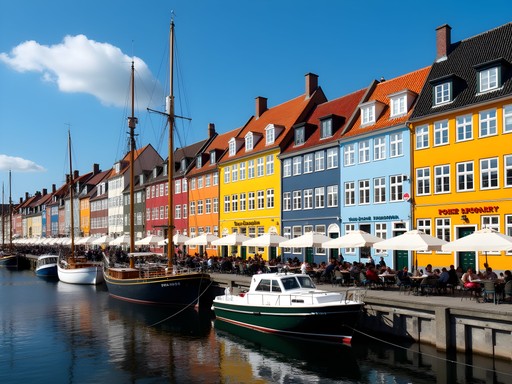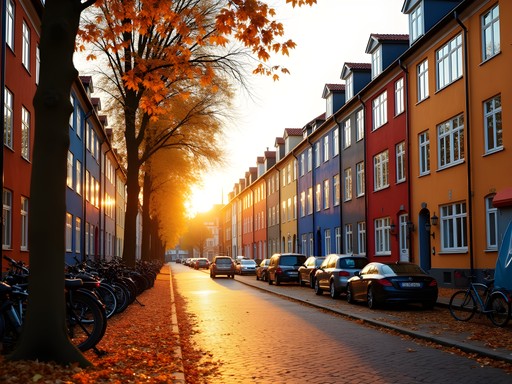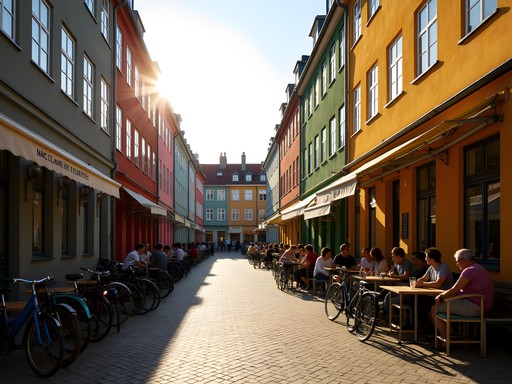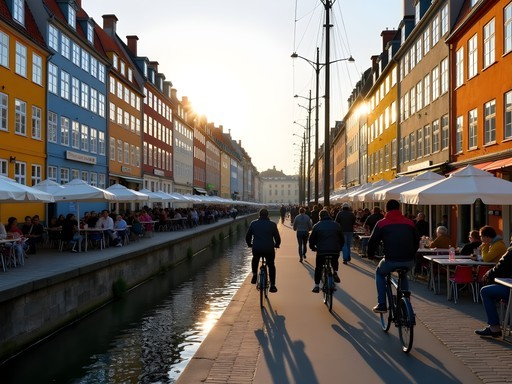Disclosure: This article contains affiliate links. We may earn a commission from purchases at no extra cost to you, which helps our travel content.
The first time I visited Copenhagen with my American father in the late '90s, Danish cuisine wasn't exactly on the global culinary map. We ate decent but forgettable meals of hearty meat and potatoes, with the occasional smørrebrød (open-faced sandwich) that hinted at something more interesting beneath the surface. Fast forward two decades, and ¡Dios mío! What a transformation! Copenhagen has engineered nothing short of a gastronomic revolution, propelling itself from a city of solid but unexceptional fare to a world-renowned culinary destination. This metamorphosis fascinates me not just as someone who appreciates good food, but as a student of how culture manifests through design—even on the plate. On my recent summer visit, I spent a week tracing this remarkable journey from traditional Danish classics to the cutting-edge New Nordic movement that has chefs worldwide taking notes.
The Foundations: Traditional Danish Cuisine
To understand Copenhagen's culinary revolution, one must first appreciate its foundations. Traditional Danish cuisine is built on the honest simplicity that characterizes much of Scandinavian cooking—practical food designed to sustain through long winters and make the most of local resources.
My exploration began at Restaurant Schønnemann, a Copenhagen institution since 1877 that feels like stepping into a time capsule. Dark wood paneling, vintage photographs, and the warm aroma of fresh bread transport you to another era. Here, I reacquainted myself with smørrebrød in its most traditional form—rye bread topped with precisely arranged combinations like pickled herring with onions and capers, or roast beef with remoulade and crispy fried onions.
'El que no arriesga, no gana' (nothing ventured, nothing gained) as we say in Spain, so I ordered the more adventurous offerings: liver pâté with bacon and mushrooms, and the notorious stegt flæsk—crispy pork belly with parsley sauce. These dishes tell the story of Danish culinary heritage—resourceful, unpretentious, and deeply satisfying.
Another cornerstone of traditional Danish cooking is frikadeller (meatballs) which I sampled at Restaurant Klubben in Vesterbro. These hand-formed treasures of pork and veal, fragrant with nutmeg and allspice, are the quintessential Danish comfort food. Paired with caramelized potatoes, pickled red cabbage, and a cold Carlsberg, they represent Danish hygge (coziness) on a plate.

💡 Pro Tips
- For authentic smørrebrød, visit during lunch hours (11:30-3:00) when it's traditionally eaten
- Make reservations at traditional restaurants at least 3-4 days in advance, especially in summer
- Try aquavit (snaps) with your smørrebrød—it's traditional and helps cut through the rich toppings
The Turning Point: Noma and the New Nordic Manifesto
If there's a single catalyst for Copenhagen's culinary transformation, it's undoubtedly Noma. When René Redzepi and Claus Meyer opened this groundbreaking restaurant in 2003, they didn't just launch a business—they ignited a movement. Their New Nordic Manifesto emphasized purity, seasonality, ethics, health, sustainability, and quality—principles that would reshape not just Danish cuisine, but global gastronomy.
Securing a reservation at Noma remains challenging (and expensive), but I was fortunate to experience their summer menu. The meal was nothing short of revelatory—a progression of dishes that told the story of the Nordic landscape through ingredients I never imagined could be transformed into haute cuisine. Fermented grasshoppers with wild berries. Sea buckthorn transformed into ethereal desserts. Vegetables treated with the reverence typically reserved for luxury proteins.
What struck me most was how the design sensibility extended beyond the food. The restaurant space itself—housed in a renovated waterfront warehouse—reflects the same philosophy as the cuisine: natural materials, clean lines, and an unpretentious elegance that feels distinctly Danish. Even the handcrafted ceramics and wooden serving pieces tell the story of Nordic craftsmanship.
For capturing these culinary masterpieces, I relied on my mirrorless camera which handled the restaurant's moody lighting beautifully without disturbing other diners with a flash. The detail it captured in these intricate dishes was remarkable—something my smartphone simply couldn't match.

💡 Pro Tips
- Book Noma 3-4 months in advance when reservations open
- If you can't get a Noma reservation, try their more accessible sister restaurant 108
- Consider lunch instead of dinner at top restaurants for a similar experience at a lower price point
The Ripple Effect: Copenhagen's Middle Market Renaissance
Perhaps the most exciting aspect of Copenhagen's culinary revolution isn't what's happening at the high end, but how it has transformed the middle market. The principles of New Nordic cuisine—seasonality, locality, innovation, and sustainability—have trickled down to create a vibrant ecosystem of restaurants serving exceptional food at more accessible prices.
Amass, founded by former Noma head chef Matt Orlando, exemplifies this evolution. Set in a converted warehouse with dramatic graffiti art and communal tables, it offers a more relaxed interpretation of New Nordic principles. Their fermentation program transforms humble ingredients into complex flavor bombs, while their zero-waste philosophy means everything finds a purpose—from vegetable scraps to bread ends.
For a casual lunch that still embodies New Nordic ideals, I visited Selma in Vesterbro. Their smørrebrød reimagines traditional Danish open-faced sandwiches with contemporary techniques and seasonal ingredients. The classic pickled herring gets updated with apple, mustard seeds, and dill, while traditional roast beef is elevated with horseradish cream, pickled cucumber, and fried shallots.
Baest represents another facet of Copenhagen's evolving food scene—restaurants applying Nordic principles to other cuisines. This organic pizzeria mills their own flour, makes cheese in-house, and sources impeccable local ingredients for their wood-fired pizzas. The result is neither traditionally Italian nor overtly Nordic, but something uniquely Copenhagen.
To navigate this culinary landscape, I relied heavily on my Copenhagen food guide which provided excellent context for understanding the city's culinary transformation alongside reliable recommendations across various price points.

💡 Pro Tips
- Many mid-range restaurants offer 'chef's choice' options that provide excellent value
- Book tables even at casual spots—Copenhagen's dining scene is popular with locals and tourists alike
- Ask for wine pairings—many restaurants have interesting natural wine programs
Market Culture: Torvehallerne and Beyond
No exploration of Copenhagen's food scene would be complete without diving into its markets, where you can experience both traditional Danish foods and New Nordic innovations in casual settings. Torvehallerne, Copenhagen's premier food market, offers a perfect crash course in Danish gastronomy under one roof.
During my visits (I returned almost daily), I developed a routine: coffee from Coffee Collective, whose light-roasted beans showcase Nordic precision and attention to detail; smørrebrød from Hallernes, where traditional recipes meet quality ingredients; and sweet treats from Grød, which elevates humble porridge to an art form.
Torvehallerne also provides an excellent opportunity to stock up on edible souvenirs. I filled my packing cubes with vacuum-sealed Danish cheeses, small-batch aquavit, and jars of Nordic preserves to recreate a taste of Copenhagen back home in Henderson.
Beyond Torvehallerne, Copenhagen's street food scenes offer additional perspectives on the city's evolving food identity. Reffen, an open-air street food market built from shipping containers on the harbor, showcases Copenhagen's multicultural side. Here, global cuisines are reinterpreted through a Danish lens—think tacos with Nordic seafood or Middle Eastern flatbreads topped with local, seasonal vegetables.
What fascinates me as someone with dual cultural heritage is seeing how Copenhagen has managed to evolve its cuisine while maintaining a strong sense of cultural identity. There's no rejection of tradition, but rather a thoughtful reinterpretation that honors the past while creating something new and distinctly Danish.

💡 Pro Tips
- Visit Torvehallerne in the morning when it's less crowded and produce is freshest
- Many market vendors offer samples—don't be shy about trying before buying
- Reffen is weather-dependent and mainly operates in summer—check opening hours before visiting
Sweet Endings: Danish Pastry Tradition Meets Innovation
In Spain, we have a saying: 'De postre, lo que sea, pero que no falte'—roughly translated as 'For dessert, anything will do, but don't skip it.' The Danes seem to share this philosophy, with their rich tradition of pastries and sweets now undergoing the same thoughtful reinvention as their savory cuisine.
The classic wienerbrød (Danish pastry) remains ubiquitous, and for good reason. At Andersen Bakery near Tivoli Gardens, I indulged in perhaps the best kanelsnurre (cinnamon swirl) of my life—buttery, perfectly laminated dough with a fragrant cinnamon filling and a subtle cardamom undertone that elevated it beyond the ordinary.
Yet contemporary pastry chefs are pushing boundaries too. At Hart Bageri, founded by former Tartine baker Richard Hart in collaboration with René Redzepi, traditional Danish pastries are reimagined with organic heritage grains, natural fermentation, and seasonal Nordic ingredients. Their cardamom buns incorporate local honey and sea buckthorn for a distinctly Danish twist on the classic.
Perhaps most emblematic of Copenhagen's sweet evolution is Lille Bakery in Refshaleøen. Founded by three Noma alumni, this community-focused bakery creates pastries that bridge tradition and innovation. Their poppy seed 'tebirkes' maintains the classic form but uses organic Danish butter and locally-milled flour, resulting in a pastry that's simultaneously familiar and revelatory.
For those with more contemporary tastes, La Glace—Copenhagen's oldest confectionery—offers 'Sports Cake,' a layered creation of crushed nougat, whipped cream, and caramelized puff pastry that has been delighting Copenhageners since 1891. Some traditions, it seems, need no reinvention.
To track my pastry adventures across the city, I used my travel journal to note each bakery's specialties and my impressions—creating both a personal memento and a reference for future visits.

💡 Pro Tips
- Visit bakeries early (before 9am) for the freshest selection
- Many bakeries are closed on Mondays—plan accordingly
- Don't miss tebirkes—a Danish specialty with poppy seeds that's less known to tourists but beloved by locals
Final Thoughts
As I boarded my flight home to Henderson, my palate still dancing with the flavors of my week-long culinary journey, I reflected on what makes Copenhagen's food scene so remarkable. It's not just the technical excellence or innovative ingredients—it's the thoughtful balance between honoring tradition and embracing change. The New Nordic revolution hasn't erased Denmark's culinary heritage; it has reframed it, asking not just 'How have we always done this?' but 'Why did we do it this way, and how might we do it better?'
For travelers seeking to understand a culture through its food, Copenhagen offers a masterclass in culinary evolution. From the humble smørrebrød to the heights of Noma's artistry, from traditional pastries to their modern reinterpretations, the city tells a compelling story of a cuisine finding its voice on the global stage while remaining distinctly, proudly Danish. ¡Buen provecho!
✨ Key Takeaways
- Copenhagen's culinary scene beautifully balances tradition and innovation
- The New Nordic movement has influenced restaurants at all price points, not just fine dining
- Markets and bakeries offer accessible entry points to understand Danish food culture
- Reservations are essential for most restaurants, even casual ones
📋 Practical Information
Best Time to Visit
May through September, with June-August being peak season
Budget Estimate
$75-150 per person per day for food (excluding fine dining experiences)
Recommended Duration
5-7 days
Difficulty Level
Beginner
















Comments
triplover
Just booked flights to Copenhagen for February after reading this! Any recommendations for places that won't break the bank but still give you that New Nordic experience? Also, is the food market open year-round?
Amit Sullivan
You'll love winter in Copenhagen! For affordable New Nordic, try Höst or Manfreds. Both offer tasting menus at reasonable prices compared to the top-tier places. And yes, Torvehallerne is open year-round - it's mostly indoors so perfect for winter. Don't miss the flødeboller (chocolate-covered marshmallow treats) at Summerbird there!
coolguy
What's one traditional Danish dish that everyone should try? Is it that smørrebrød thing you mentioned?
triplover
Not the author but YES to smørrebrød! Also try frikadeller (meatballs) and flæskesteg (roast pork with crackling). Danish pastries are obviously a must too - but they call them 'wienerbrød' there!
Amit Sullivan
Mark, your comparison between your visits decades apart resonated with me. I had a similar experience with Copenhagen's transformation. In 1997, I remember ordering what was supposed to be a 'traditional Danish meal' that turned out to be a bland affair of boiled potatoes and uninspired meat. Fast forward to last year, and even the traditional dishes have been elevated with better techniques and ingredients. The reverence for seasonality reminded me of Japanese cuisine's approach to ingredients. What fascinates me most is how they've embraced their Nordic limitations rather than fighting them. Instead of importing Mediterranean ingredients, they've found magic in fermentation, preservation, and foraged items. The sauces made from berries I'd never heard of were revelations. My favorite memory was watching my wife's face when she tried pickled green strawberries for the first time at 108 (Noma's former sister restaurant) - pure culinary surprise!
islandexplorer9281
Just got back from Copenhagen last month and this post captures the food scene perfectly! We couldn't get into Noma (no surprise) but had incredible meals at Amass and Baest. The thing that amazed me was how even casual places have such high-quality ingredients. We grabbed hot dogs from a pølsevogn (hot dog stand) that were better than fancy sausages back home! I'd add that for budget travelers, many bakeries offer amazing cardamom buns and other pastries that make for affordable breakfasts. I kept my food guide with me the whole time and it led us to some amazing neighborhood spots.
waveninja
Great post! Going to Copenhagen next month for the first time. Is Torvehallerne market worth visiting even in winter? Any specific food stalls you'd recommend there?
islandexplorer9281
Not the author but I was at Torvehallerne in December last year and it was amazing! Definitely check out Hallernes Smørrebrød for traditional open-faced sandwiches and Coffee Collective for the best coffee. The indoor setup makes it perfect for winter visits!
waveninja
Thanks so much for the tips! Adding those to my list right now!
Taylor Moreau
Mark, excellent overview of Copenhagen's culinary transformation. I've been visiting Copenhagen regularly for business since 2005, and the evolution has been remarkable. The first time I visited Noma in 2008, I knew something extraordinary was happening. What impresses me most is how the New Nordic philosophy has trickled down to more accessible price points. On my last trip, I had an exceptional meal at Relæ that rivaled fine dining experiences at half the cost. The commitment to local, seasonal ingredients is genuine rather than merely trendy. Have you tried any of the smørrebrød workshops? They're becoming popular with visitors wanting hands-on experience with traditional Danish cuisine.
moonlegend
Taylor, is Relæ more affordable than Noma? Looking for something special but not completely budget-breaking!
Taylor Moreau
Yes, definitely more affordable than Noma! Still a splurge but you're looking at roughly half the price. They have a Michelin star but maintain a more relaxed atmosphere. Book well in advance though!
moonlegend
Wow, Copenhagen's food scene has come so far! Dying to try Noma one day, if I can ever get a reservation (and afford it lol)!
beachguide
Those food photos are making me hungry! Copenhagen wasn't on my radar before but it is now!
Oliver Duncan
Great write-up on Copenhagen's food scene, Mark! As a budget traveler, I was initially worried about eating well in such an expensive city, but I found some fantastic workarounds. The food halls were my savior - not just Torvehallerne, but also Reffen street food market which has more affordable options in repurposed shipping containers. For those wanting to try New Nordic cuisine without the hefty price tag, many restaurants offer lunch menus that are significantly cheaper than dinner service but feature similar techniques and ingredients. I also rented an Airbnb with a kitchen and shopped at local supermarkets like Irma, which carry high-quality Danish products. The rye bread, cheese, and aquavit made for perfect DIY smørrebrød at a fraction of restaurant prices!
Mark Griffin
Thanks Oliver! Great tip about Reffen - I didn't make it there on this trip but have heard amazing things. The lunch menu hack is spot-on too.
exploretime
If you're into the New Nordic scene but can't get a reservation at the top spots, many chefs have opened more casual sister restaurants. We tried Barr (by the Noma team) and it was fantastic - they focus on Northern European beer culture and food. Also, don't miss the bakeries! Danes make incredible bread and pastries. Hart Bageri was our favorite.
Venture X
Premium card with 2X miles, $300 travel credit, Priority Pass